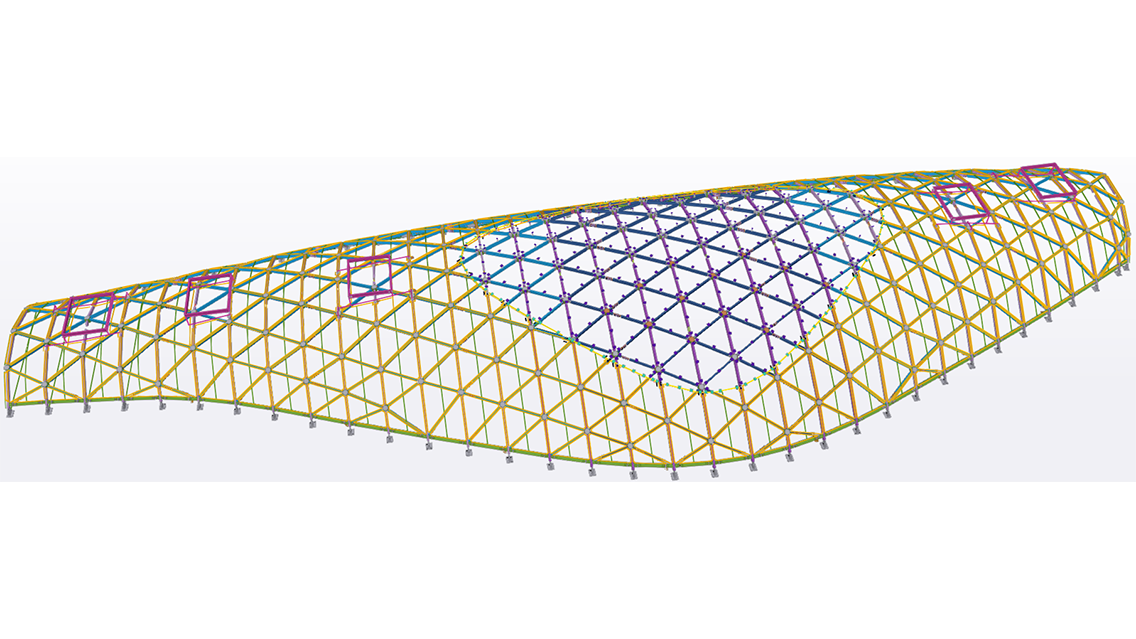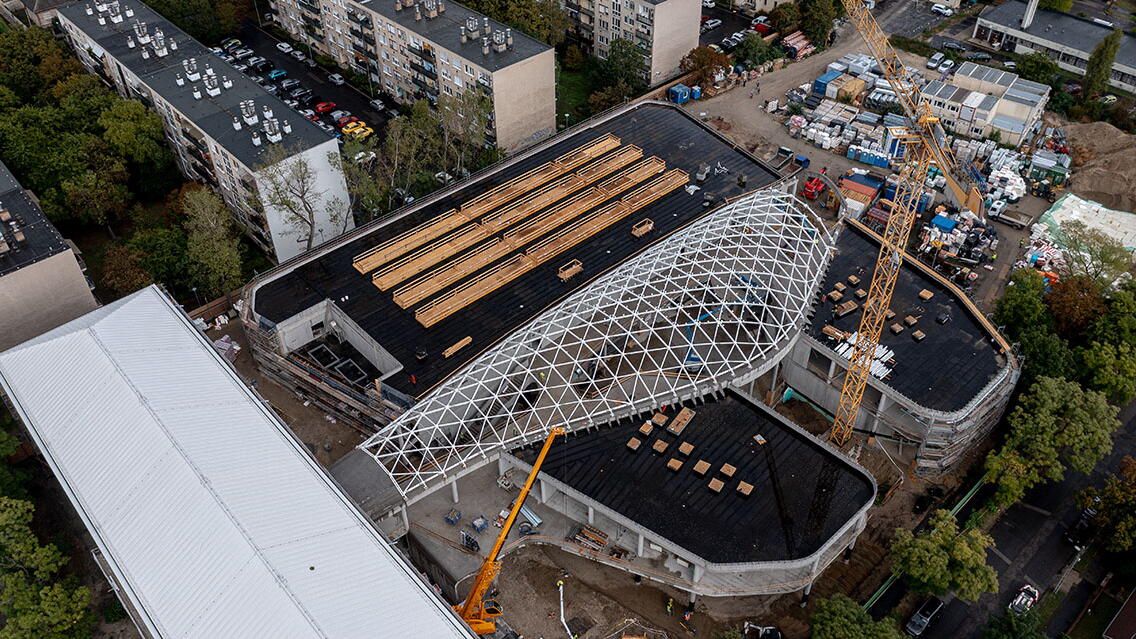The project is located in the Csepel district of Budapest, where the renewal of the old high school, expansion of 6500 m2, and a complete reconstruction took place. After the conceptual design phase, BIM GROUP Ltd. was responsible for the subsequent stages, including the preparation of the permit documentation, execution design, and detailed design, with the involvement of our five disciplines (architecture, reinforced concrete structures, steel structures, building envelope, MEP engineering). The main structural design challenge of the project was the coverage of the Assembly Hall, for which we needed sufficient experience, practice, and the appropriate softwares. For this competition, we submit the double-curved freeform steel structure that is outstanding from an architectural perspective as well. One of the main pillars and innovative tools used for the complex steel structure’s design for manufacturing and assembly was the parametric/algorithmic design.
The roof structure of the Assembly Hall
The visible steel structure, spanning 84 meters in length and 25 meters in width, features a glass dome skylight at its center. The non-glass part of the structure is covered with a Zambelli RIB-ROOF metal roof system with a rainscreen cover.
The steel structure is supported on two monolithic reinforced concrete perimeter beams with a general cross-section of 50×75 cm, which are curved both horizontally and vertically. The perimeter beams were aligned with the double-curved surface envisioned by the architects during the conceptual design. We examined the irregular form and realized that while it was possible to realize this geometry with a curved and bent structural system, the manufacturing process would be extremely expensive and could be imprecise. Therefore, we rationalized the double-curved surface even during the permitting phase using a parametric-algorithmic design software, Rhinoceros 3D and its built-in Grasshopper plugin.
The process of the Conceptual Design
For the easiest fixing of the cladding, we divided the roof structure into flat, triangular surfaces. To achieve the triangular geometry, we divided the curves into segments, which also had the advantage of the initial rationalization of the surface.
Based on the boundary conditions, we conducted topological iterations and preliminary structural design. This task was carried out within a parametric environment using the Pangolin plugin, which allows a live connection between Grasshopper and Consteel FEM software. Essentially, this allowed rapid generation of various concepts within Grasshopper and calculates them under a representative load combination in Consteel in terms of structural behavior and material utilization. The concepts were different in terms of either the truss arrangement or the static frame. In the end, the structural system is built up of 34 main beams, 576 cross beams, and 66 perimeter beams.
The process of the Detailed Design
During the detailed design phase, our primary optimization goal was to determine and develop the typical technical solutions. With the help of the Tekla plugin in Grasshopper, which provides a live connection between Grasshopper and Tekla Structures, the complete shop detailing model (adaptable to any geometry) can be created relatively easily and in a controlled manner. This method allowed us to model and automate multiple identical principle joints (in our case, 710) with varying geometries using a single properly parameterized Tekla custom component with the help of Grasshopper.
For the trapezoidal sheeting of the metal roof, secondary triangular frames with rectangular cross-section were designed. Each of these frames are welded and provide flat surfaces for the cladding. These assemblies are fixed to the main structure at evenly distributed threaded rods using a special clamping solution. The challenge here, as well, of this task was the variety of geometries. However, with the help of programmed modeling, we were able to create the geometry of the secondary components quickly and importantly, without any additional design inaccuracies. Approximately 95% of the entire roof was created with a programmed modeling, including the numerous threaded rods and other small elements.
Summary
As a result of the design process, we optimized the steel structure for manufacturing and assembly (with the aid of trial fabrication and trial erection process), reducing production and erection lead times as well as costs.
During the project, the applied working method allowed us to significantly accelerate the conceptual design, the preliminary structural design, decision preparation and the detailed design as well. By using a few appropriately selected and optimized joint types, the shop detailing model was programmatically and automatically created for this complex geometry.
In addition, another advantage in the project was the implementation of parallel task execution. After determining the structural system and the conceptual definition of the joints, two separate teams worked on the structural detailing and the parametric-algorithmic program code. The calculation results (plate thicknesses, weld sizes, bolt dimensions, etc.) were easily integrated into the program code as well as the optimization considerations made during the trial fabrication and trial erection process.
On behalf of all the colleagues of BIM.GROUP Ltd., we take great pride in the remarkable outcome of the project.
Project parties:
Investor: Beruházási Ügynökség BMSK Zrt.
General contractor: LATEREX Építő Zrt.
Tender and execution design, detailed design: bim.GROUP Kft.
The structural designer partner of bim.GROUP Ltd: BVK-PRO, s.r.o.
The steel detail designer partner of bim.GROUP Ltd: RKK Team Kft.
Contractor of steel and metal roof systems: KÉSZ Metaltech Kft.
Steel manufacturer: KÉSZ Ipari Gyártó Kft.
Metal roof manufacturer: Baumetall Design Kft.
Glass dome skylight: Schal-Tech Kft.





